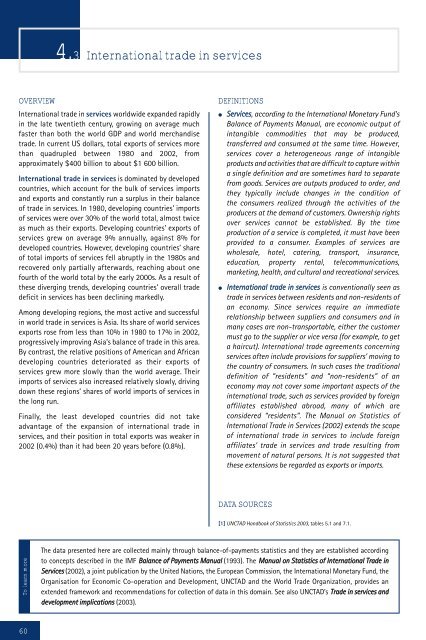Development and Globalization: - Unctad
Development and Globalization: - Unctad
Development and Globalization: - Unctad
Create successful ePaper yourself
Turn your PDF publications into a flip-book with our unique Google optimized e-Paper software.
OVERVIEW DEFINITIONS<br />
International trade in services worldwide exp<strong>and</strong>ed rapidly<br />
in the late twentieth century, growing on average much<br />
faster than both the world GDP <strong>and</strong> world merch<strong>and</strong>ise<br />
trade. In current US dollars, total exports of services more<br />
than quadrupled between 1980 <strong>and</strong> 2002, from<br />
approximately $400 billion to about $1 600 billion.<br />
International trade in services is dominated by developed<br />
countries, which account for the bulk of services imports<br />
<strong>and</strong> exports <strong>and</strong> constantly run a surplus in their balance<br />
of trade in services. In 1980, developing countries’ imports<br />
of services were over 30% of the world total, almost twice<br />
as much as their exports. Developing countries’ exports of<br />
services grew on average 9% annually, against 8% for<br />
developed countries. However, developing countries’ share<br />
of total imports of services fell abruptly in the 1980s <strong>and</strong><br />
recovered only partially afterwards, reaching about one<br />
fourth of the world total by the early 2000s. As a result of<br />
these diverging trends, developing countries’ overall trade<br />
deficit in services has been declining markedly.<br />
Among developing regions, the most active <strong>and</strong> successful<br />
in world trade in services is Asia. Its share of world services<br />
exports rose from less than 10% in 1980 to 17% in 2002,<br />
progressively improving Asia’s balance of trade in this area.<br />
By contrast, the relative positions of American <strong>and</strong> African<br />
developing countries deteriorated as their exports of<br />
services grew more slowly than the world average. Their<br />
imports of services also increased relatively slowly, driving<br />
down these regions’ shares of world imports of services in<br />
the long run.<br />
Finally, the least developed countries did not take<br />
advantage of the expansion of international trade in<br />
services, <strong>and</strong> their position in total exports was weaker in<br />
2002 (0.4%) than it had been 20 years before (0.8%).<br />
To learn more<br />
60<br />
4.3 International trade in services<br />
● Services, according to the International Monetary Fund’s<br />
Balance of Payments Manual, are economic output of<br />
intangible commodities that may be produced,<br />
transferred <strong>and</strong> consumed at the same time. However,<br />
services cover a heterogeneous range of intangible<br />
products <strong>and</strong> activities that are difficult to capture within<br />
a single definition <strong>and</strong> are sometimes hard to separate<br />
from goods. Services are outputs produced to order, <strong>and</strong><br />
they typically include changes in the condition of<br />
the consumers realized through the activities of the<br />
producers at the dem<strong>and</strong> of customers. Ownership rights<br />
over services cannot be established. By the time<br />
production of a service is completed, it must have been<br />
provided to a consumer. Examples of services are<br />
wholesale, hotel, catering, transport, insurance,<br />
education, property rental, telecommunications,<br />
marketing, health, <strong>and</strong> cultural <strong>and</strong> recreational services.<br />
● International trade in services is conventionally seen as<br />
trade in services between residents <strong>and</strong> non-residents of<br />
an economy. Since services require an immediate<br />
relationship between suppliers <strong>and</strong> consumers <strong>and</strong> in<br />
many cases are non-transportable, either the customer<br />
must go to the supplier or vice versa (for example, to get<br />
a haircut). International trade agreements concerning<br />
services often include provisions for suppliers’ moving to<br />
the country of consumers. In such cases the traditional<br />
definition of “residents” <strong>and</strong> “non-residents” of an<br />
economy may not cover some important aspects of the<br />
international trade, such as services provided by foreign<br />
affiliates established abroad, many of which are<br />
considered “residents”. The Manual on Statistics of<br />
International Trade in Services (2002) extends the scope<br />
of international trade in services to include foreign<br />
affiliates’ trade in services <strong>and</strong> trade resulting from<br />
movement of natural persons. It is not suggested that<br />
these extensions be regarded as exports or imports.<br />
DATA SOURCES<br />
[1] UNCTAD H<strong>and</strong>book of Statistics 2003, tables 5.1 <strong>and</strong> 7.1.per No. 159.<br />
The data presented here are collected mainly through balance-of-payments statistics <strong>and</strong> they are established according<br />
to concepts described in the IMF Balance of Payments Manual (1993). The Manual on Statistics of International Trade in<br />
Services (2002), a joint publication by the United Nations, the European Commission, the International Monetary Fund, the<br />
Organisation for Economic Co-operation <strong>and</strong> <strong>Development</strong>, UNCTAD <strong>and</strong> the World Trade Organization, provides an<br />
extended framework <strong>and</strong> recommendations for collection of data in this domain. See also UNCTAD’s Trade in services <strong>and</strong><br />
development implications (2003).

















